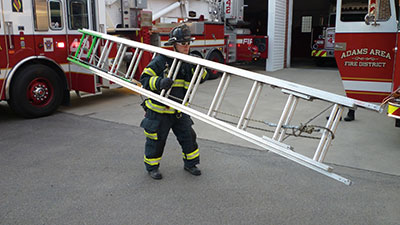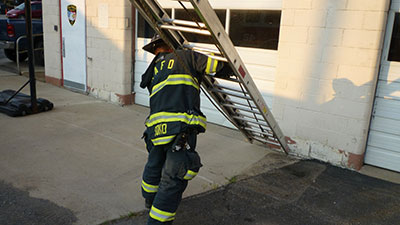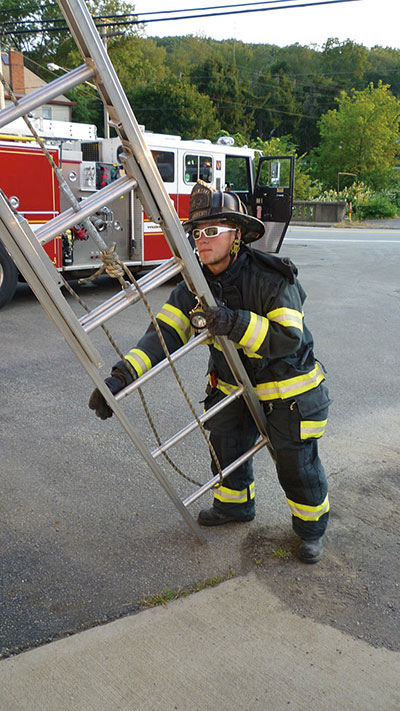
Features
Training
Tim-Bits: October 2013
As a fire instructor, I firmly believe that the fundamentals of firefighting operations should be mastered by each and every firefighter through a formal and recognized educational delivery system.
September 27, 2013
By Tim Llewellyn
As a fire instructor, I firmly believe that the fundamentals of firefighting operations should be mastered by each and every firefighter through a formal and recognized educational delivery system. After the essential skills are mastered, individuals can then broaden their skill sets by learning new techniques and adapting them to the realities they face on their actual day-to-day fire-ground environment. Such is the topic of this edition of Tim-Bits: ladders.
In our recruit schooling, we learn to place various sized ladders against buildings in teams of two, three or even four firefighters. We learn the beam raise and the flat raise, and how to identify and avoid aerial obstacles as we manoeuvre the ladders. All of these skills are taught with teamwork in mind – raise the ladder as a team, lower it as a team. This teamwork concept is great at instilling the basic mechanical steps of ladder placement; however, on an actual fire ground, there may not be enough firefighters to raise the ladder as a team. At every fire I have attended, there has never been enough boots on the ground to accomplish all of the tasks that need doing in the first 10 minutes of arrival. During those times of short staffing, firefighters must rely on their education and accomplish tasks safely and efficiently without unnecessarily taking firefighters away from other important fire-ground
activities.
With all single-firefighter ladder carries, it is important to consider one’s physical health and strength. Ladders are heavy – if you cannot lift a ladder or have difficulty lifting, carrying or raising a ladder with a two-firefighter technique, single-firefighter ladder raises are not for you.
 |
|
| Photo 1: At the balance point of the ladder, raise it to a shoulder carry position with the base section of the ladder against the body; this is the most effective way for one firefighter to carry a ladder. |
|
 |
|
| Photo 2: Place the heels of the ladder at the bottom of the building where the ground and the wall meet. This corner will securely foot the ladder as it is raised. |
|
 |
|
| Photo 3: When rolling a ladder, be sure to keep your feet wider than the ladder and control the ladder’s movement with both hands, keeping firm control throughout the movement to avoid any undesired motion. Photos by Tim Llewellyn |
It is important to find and mark the balance points of the ladders. Typically, single-section ladders and two-section ladders up to 8.5 metres (28 feet) are suitable for single-firefighter raises. Remove the ladder from the apparatus and, at the balance point, raise it to a shoulder carry position with the base section of the ladder against the body – this is the most effective way for one firefighter to carry a ladder (see photo 1).
For a single-firefighter ladder raise to a window, advance toward the building with the heels (or spurs) of the ladder in front of you, in the direction of travel. The object is to use the building, instead of another firefighter, to foot the ladder against the ground to permit safe raising. As you approach the building, check for overhead obstructions. With the ladder in the shoulder carry position, lean away from the ladder and lift it from your body so that it levels to a flat position. At the same time, pick a spot one ladder-width to the left or the right of the target window and place the heels of the ladder at the bottom of the building where the ground and the wall meet. (A single-section ladder can be placed directly under the target window.) This corner will securely foot the ladder as it is raised (see photo 2). With the heels of the ladder in the ground/building corner, raise the ladder against the building with a hand-over-hand technique on the rungs. Once the ladder is firmly against the building, move the base of the ladder away from the wall to achieve a proper climbing angle by grasping rungs two and five. If the ladder needs to be extended, move the heel of the ladder away from the building approximately 30 centimetres. Now pull the halyard, hand-over-hand, to raise the ladder to the desired height. The tip of the ladder slides up the building as the halyard is pulled. Once the ladder is raised to the desired height, move the ladder into a proper climbing angle as described earlier by grasping rungs two and five and moving the bottom of the ladder away from the building. Now, the ladder can be rolled into the proper climbing position (with the fly out or away from the building) to the window. When rolling a ladder, be sure to keep your feet wider than the ladder and control the ladder’s movement with both hands, keeping firm control throughout the movement to avoid any undesired motion (see photo 3).
This simple modification of a basic ladder-raise technique has proven to be a safe, time-saving technique. Like the more basic ladder skills, it requires practice in order to become proficient. Now, go practise these techniques!
Tim Llewellyn is a career firefighter for the Allegheny County Airport Authority in Pittsburgh, Penn. A volunteer firefighter since 1989, he currently serves for the Adams Area Fire District in Pennsylvania. He has recently been appointed as a suppression-level instructor for the Pennsylvania State Fire Academy. He has taught structural firefighting tactics extensively in Canada and the U.S. E-mail him at llewllyn.fire@gmail.com
Print this page